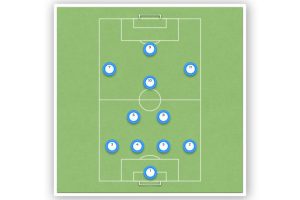Box-to-Box Midfielder vs. Attacking Midfielder: Understanding the Key Differences
When it comes to soccer, midfielders play one of the most important roles in the game. They are responsible for connecting the defense and the offense, controlling the pace of the game, and winning possession of the ball. Two common types of midfielders are the box-to-box midfielder and the attacking midfielder. While both positions share some similarities, they have distinct differences in terms of their roles and responsibilities on the field.
A box-to-box midfielder is a player who is effective both in defense and in attack. They are expected to cover a lot of ground during a game, moving from box to box to help their team both offensively and defensively. They are typically known for their high work rate, stamina, and ability to win duels and possession of the ball. In contrast, an attacking midfielder is a player who operates in a free role behind the striker/s, often serving as a playmaker or shadow striker. They are responsible for creating scoring opportunities for their team and are typically known for their creativity, vision, and passing ability.
While both box-to-box midfielders and attacking midfielders are important players on the field, they have different roles and responsibilities. Understanding the differences between the two positions can help coaches and fans better appreciate the unique skills and contributions of each player type. In the following sections, we will explore the key differences between box-to-box midfielders and attacking midfielders in more detail.
Defining the Terms
Box-to-Box Midfielder
A box-to-box midfielder is a player who covers a lot of ground on the field, participating in both attack and defense. This type of midfielder is known for their stamina, work rate, and ability to transition the ball from defense to attack quickly. They are expected to affect the game in all areas of the field, making tackles and interceptions in their own half and creating chances and scoring goals in the opposition half. Box-to-box midfielders are versatile players who can adapt to different systems and styles of play. They are often referred to as the “engine” of the team, as they provide the link between defense and attack. Examples of box-to-box midfielders include Leon Goretzka of Bayern Munich and N’Golo Kante of Chelsea.
Attacking Midfielder
An attacking midfielder is a player who operates in the space between the midfield and the attack, playing in a free role behind the striker/s as a playmaker or a shadow striker. They are responsible for creating chances and scoring goals, using their vision, creativity, and technical ability to unlock opposition defenses. Attacking midfielders are often referred to as the “number 10” of the team, as they traditionally wore the number 10 shirt. They are key players in possession-based systems, where they are expected to dictate the tempo of the game and provide the final pass or finish. Examples of attacking midfielders include Kevin De Bruyne of Manchester City and Bruno Fernandes of Manchester United. In summary, box-to-box midfielders are known for their all-round ability and work rate, while attacking midfielders are known for their creativity and ability to unlock defenses. Both types of midfielders are crucial to a team’s success and play different roles on the field.
Key Differences
Playing Style
Box-to-box midfielders and attacking midfielders have different playing styles. A box-to-box midfielder is a versatile player who covers a lot of ground and plays both defensively and offensively. They are known for their stamina, strength, and ability to win duels. They often participate in both attack and defense, making runs up the field to support the strikers and coming back to defend when needed. On the other hand, an attacking midfielder is primarily focused on the offensive aspect of the game. They are creative players who occupy the space between the midfield and the attack, operating in a free role behind the striker/s as a playmaker or a shadow striker. They are responsible for creating scoring opportunities for the team and often have excellent dribbling and passing skills.
Role in the Team
The roles of box-to-box midfielders and attacking midfielders in the team are also different. A box-to-box midfielder is a more defensive player who is responsible for winning the ball back and distributing it to the attacking players. They are often considered the engine of the team, as they cover a lot of ground and provide support to both the defense and the attack. In contrast, an attacking midfielder is an offensive player who is responsible for creating scoring opportunities for the team. They often play behind the strikers and are expected to be the creative force in the team.
Attributes
Box-to-box midfielders and attacking midfielders also have different attributes. Box-to-box midfielders are known for their physical attributes, such as stamina, strength, and pace. They are often tall and have good aerial ability, which makes them effective in both attack and defense. Attacking midfielders, on the other hand, are known for their technical attributes, such as dribbling, passing, and shooting. They are often smaller and more agile than box-to-box midfielders, which allows them to maneuver around defenders and create scoring opportunities for the team.
Similarities
Box-to-box midfielders and attacking midfielders share some similarities in their roles and responsibilities on the field. Both positions require a player to have a high level of technical skill, tactical awareness, and physical fitness. They both operate in the middle third of the field, with the attacking midfielder typically playing in a more advanced position than the box-to-box midfielder.
Both positions are involved in the team’s attacking play, with the attacking midfielder being the primary playmaker and the box-to-box midfielder providing support and contributing to the build-up play. They both need to be able to make accurate passes, create chances for their teammates, and score goals themselves.
Defensively, both positions are required to help win the ball back for their team. The attacking midfielder may press high up the field to disrupt the opposition’s build-up play, while the box-to-box midfielder is responsible for breaking up the play in the middle of the field and providing cover for the defense.
Overall, while there are differences between the two positions, they share many similarities in terms of their technical ability, tactical awareness, and physical fitness. Both positions are crucial to a team’s success, and a skilled box-to-box midfielder or attacking midfielder can make a significant impact on the game.
Conclusion
While both box-to-box midfielders and attacking midfielders are important positions on the field, they have distinct roles and responsibilities. Box-to-box midfielders are known for their ability to cover ground and contribute both offensively and defensively. They are often tasked with breaking up the opposition’s play and initiating counterattacks. Attacking midfielders, on the other hand, are focused on creating chances and scoring goals. They are often given more freedom to roam and operate in the final third of the field.
It’s important to note that these roles are not mutually exclusive. A player can have qualities of both a box-to-box midfielder and an attacking midfielder, and many players are able to play in multiple positions. Additionally, the tactics and formations used by a team can influence the responsibilities of each position.
Ultimately, the difference between a box-to-box midfielder and an attacking midfielder comes down to their primary focus on the field. Box-to-box midfielders are more versatile and contribute in multiple areas, while attacking midfielders are more specialized in creating and finishing chances. Both positions are crucial for a team’s success, and a balance of both is necessary for a well-rounded and effective midfield.






